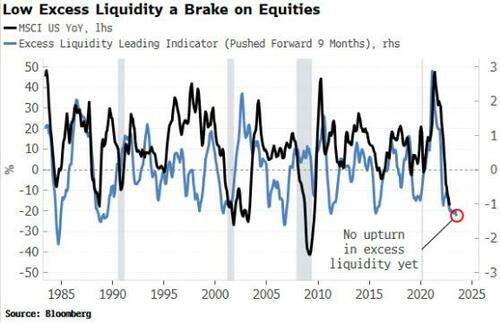
Authored by Simon White, Bloomberg macro strategist,
Equities will remain mired in a bear market until we see a turnaround in global growth, a revival in investor sentiment and positioning, and a resurgence in excess liquidity.
Seasonally, the last quarter of the year is the best for US equities and this year, despite the misery of the bear market (if you’re a long-only investor), the fourth quarter is on course to be by far the best – and only positive – one of the year.
But this is not a new dawn, and even if the year manages to finish on a festive high, the throbbing headache of the bear market will return in 2023, due to (at least) three major headwinds for US stocks.
First, there is the ongoing global slowdown. Higher rates around the world along with protracted Covid restrictions in China have blunted global growth. Rates around the world looked to have turned a corner, and peak global hawkishness is behind us, but it will take time for this to feed through.
Further, in China, even though there is incremental easing in Covid measures, a strong and immediate bounce back can’t be assumed when the populace has been living in fear to a virus most of the rest of the world has adapted to with the help of effective vaccines.
One of the best barometers of global growth is South Korean exports. As a small, open, trading economy, its exports are sensitive to the cross-currents in global growth. As the chart below shows, US earnings will face mounting headwinds while South Korean exports continue to fall. Moreover, we are unlikely to see a bounce in P/Es while inflation remains elevated.
Second, investor sentiment and positioning in equities continues to weaken. Retail-investor cash positions continue to rise to the detriment of their stock allocations, according to the AAII, while institutional cash holdings are below their long-term average, according to BAML.
On top of this, investors continue to pull money out of their stock-margin accounts, to levels only seen in recessions, and consistent with further declines in equity prices.
Finally, and most importantly, equities are highly unlikely to stage a sustainable rally until we see a decisive pivot in excess liquidity, the difference between real money growth and economic growth.
While monetary conditions remain tight, growth is still positive and inflation is elevated, excess liquidity will remain low and act as a major brake on stock prices.
Loading…

